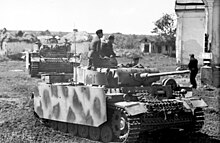Armored apron

Panzer III with side aprons
Armored aprons , also side skirts , as protection of tanks against attacks on their side armor, were developed during the Second World War . During the war against the Soviet Union , German tanks tried to protect themselves against Soviet tank destroyers armed with anti- tank rifles , and reinforced the side armor of Panzer III and IV with armor plates attached to rails.
- In the case of the Panzer III Ausf. M / N, 5 mm thick armor plates were attached to the side of the hull and the turret, which were loosely hung at least on the hull.
- Also with assault guns based on Panzer III or IV on the hull.
- In the case of the Panzer IV Ausf. G / H / J, 5 mm thick armor plates were also attached to the side of the hull and the turret. In the case of the Ausf. J, meshwork was also attached towards the end of the war, which achieved a similar effect, but used significantly less material.
- Armor plates were also attached to the hull of the Panzer V Panther, but they only covered a small area of the landing gear.
Towards the end of the Second World War, light cage armor appeared, but it only protected against shaped charges.
Today, various tank models such as the T-80 or the Merkava have reactive armor on the aprons.
Individual evidence
- ↑ Steven J. Zaloga: Bazooka vs Panzer: Battle of the Bulge 1944 , Bloomsbury Publishing , 2016, ISBN 9781472812513 [1]